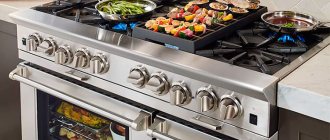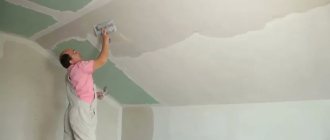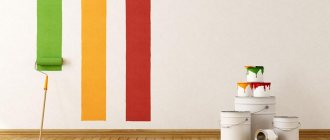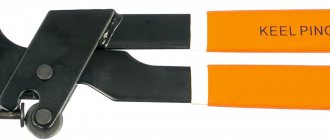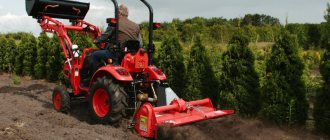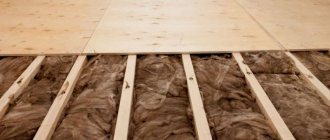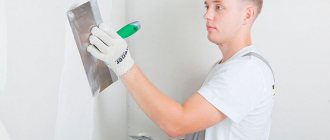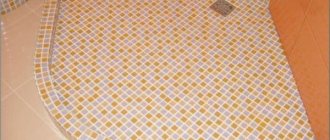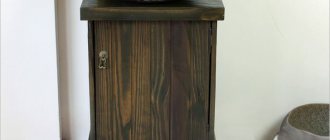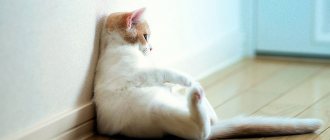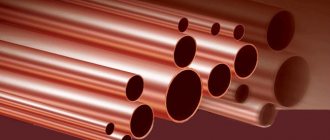In various articles on our website, two types of sheet material are constantly mentioned: plasterboard (gypsum board) and gypsum fiber sheets (GVL). Feedback from portal visitors showed that not all home craftsmen know the difference between them, and, therefore, do not always choose the right building material for a specific situation.
Therefore, let’s pay closer attention to the topic and consider which is better - gypsum fiber board or drywall when finishing walls, lining the ceiling and leveling the floor. To do this, we will consider the characteristics of the materials, their advantages and disadvantages, which will allow us to understand the difference between gypsum boards and gypsum fiber boards and determine whose set of qualities is best suited under the current operating conditions.
What is drywall (gypsum plasterboard)
Drywall (the word is derived from the term plasterboard sheet) is a building material of varying sizes and thicknesses made from a hardened layer of gypsum dough (core), covered on both sides with cardboard (construction paper). The second name is dry gypsum plaster (in English-speaking countries - drywall).
The material was first obtained in the USA in the second half of the 19th century. It acquired its modern appearance in the 20th century. And again the author of the invention was the American Utsman.
Compound
GKL contains only natural ingredients:
- gypsum (core) - 93%;
- paper (cardboard lining) - 6%;
- water, starch (in gypsum) and sheet coating - 1%.
Attention: the amount of water indicated is in a dry state. During operation, the indicator can change significantly due to the hygroscopicity of gypsum plasterboard.
Kinds
According to established habit, gypsum board is divided into 3 types:
- classic (standard). Denoted by the abbreviation GKL. Cardboard color is gray. The marking is blue. Used for finishing work in rooms with normal operating conditions;
- moisture resistant (GKLV). Resistance to moisture is acquired after impregnation of the gypsum mixture (before molding) with a special waterproofing compound, as a result of which the gypsum absorbs water 10 times less, while quickly releasing it. Recently, antifungal additives have been added to the impregnation. The leaves are green with blue markings. Used in damp areas;
- fireproof (GKLO). The addition of fire retardants, and from leading manufacturers of crystallized water, gives the material high heat resistance - such sheets can resist open fire for up to an hour. The color is pink, the inscription is bright red.
There is another type that is not talked about much: moisture-resistant drywall with increased fire resistance (GKLVO) . It is a combination of moisture-resistant and fire-resistant material. It turns green. The marking is red.
For information: since 2015, the name of plasterboard in construction documentation has been changed to “gypsum building boards” (GSP).
Shapes and sizes
On sale you can find sheets of the following sizes:
- thickness - 8.0; 9.5; 12.5; 14.0; 16.0 mm. The most popular are 9.5 and 12.5 mm;
- width - 120 and 60 cm (rarely 90 cm);
- length - 2.0; 2.5; 3.0; 3.5 and 4.0 m. Sheets with a length of 2.5 and 3 m are in greatest demand, which is mainly due to the height of the ceilings in the house (apartment).
The shape is rectangular sheets. Differences on the side edge. She may be:
- straight - indicated in the marking by a combination of letters PC;
- thinned (UK);
- semicircular (PLC);
- semicircular thinned (PLUK);
- rounded (ZK).
Types of edges.
Purpose
Drywall is used to level walls and ceilings and construct various partitions. You can stick wallpaper and tiles on it, apply decorative plaster, liquid wallpaper. In addition, the surface can be painted with almost all types of paint.
Manufacturers
The best quality gypsum board of the following brands:
- "KNAUF";
- “Saint-Gobain” is a trademark of the Gyproc concern;
- "Lafarge";
- "Volma";
- "BelGips".
What is GVL (gypsum fiber sheets)
Gypsum fiber sheets (GVL) are a mixture of building gypsum, fluffed waste paper (cellulose fibers firmly bind the set gypsum in all directions, giving the material high strength and viscosity) and technological additives. The mass is filled with water, stirred, pressed into sheets, and dried.
GVL with an unusual edge.
Compound
The gypsum fiber sheet has a uniform structure, without a cardboard shell. Consists of:
- from gypsum - 80-85%;
- cellulose - 10-15% (most materials indicate 20%, but this is not so);
- special additives (they are also called technological additives) - 5%.
Kinds
Like drywall, gypsum board has 4 types:
- simple (GVL). Used in rooms with moderate humidity and slight temperature changes;
- moisture resistant (GVLV) - thanks to hydrophobic additives, it practically does not absorb water. Recommended by manufacturers for use in wet areas (bathroom, shower, kitchen);
- fire-resistant (GVLO). The material itself does not burn. But in some cases, increased fire-resistant qualities are needed, for example, for lining air ducts, communication shafts, wooden walls when working in a room with an open fire, etc.;
- moisture- and fire-resistant (GVLVO) types are produced for saunas, baths, i.e. for those rooms where there are extreme operating conditions.
It is impossible to determine the type by color - all the sheets are gray. Markings on the back of the plate will help.
GVL marking.
In addition, GVL can be:
- polished (in the marking it is indicated by the letter “Ш”) - the operation is performed for painting;
- unsanded (NS) - for wallpaper, tiles, dry floor screed, etc.
Shapes and sizes
According to GOST, gypsum fiber sheets can be of the following sizes:
- thickness - 10.0; 12.5; 15.0; 18.0; 20.0 mm;
- width - 50.0; 100.0; 120.0 cm;
- length - 1.5; 2.0; 2.7; 3.0 m.
For the population, a sheet of 10 x 1500 x 1200 mm is considered standard.
Please note: products are available in other sizes. For example, floor slabs 120 x 120 x 2 cm. Before purchasing, you need to look at the markings or ask the seller. The edge can be straight (PC) and folded (FC). If necessary (for reinforcing tape), you can thin the edge of the sheet yourself using a carpenter's plane.
Types of edges.
Purpose
Gypsum fiber sheets have a wider range of applications compared to gypsum boards, both in terms of types of buildings and structural elements. GVL is used in residential and non-residential premises, balconies and loggias, baths and saunas for leveling (cladding) walls, installing partitions, lining the ceiling, as a base floor for tiles, linoleum, laminate, parquet and parquet boards.
In addition, the material is widely used in industrial construction.
You can finish gypsum fiber board on the walls using:
- wallpaper - paper, vinyl and textile hold up well. Glue only based on methylcellulose. Problems arise with non-woven trellises;
- paints. Here, firstly, you need polished slabs (putty is expensive and labor-intensive due to several layers), secondly, you cannot paint with silicate-based paints;
- decorative plaster - gypsum solutions with additives from artificial resins are allowed;
- ceramic tiles.
Important: the surface needs to be primed before finishing.
Manufacturers
Main brands of GVL manufacturers:
- “Knauf” - about 70% of the market in Russia and the CIS countries belongs to this product, “Nida Gips”, “Rigips” - another 10% for three;
- "Volma";
- "BelGips";
- "GIFAS" and others.
Cost overview
Gypsum fiber sheet Knauf/Knauf Supersheet FC moisture resistant 2500x1200x10 mm
630.00 rub.
Product code 27
Knauf Superlist FC is a high-quality, environmentally friendly, moisture-resistant plasterboard for dry p.....
Gypsum fiber sheet Knauf/Knauf Superlist FC moisture resistant 2500x1200x12.5 mm
720.00 rub.
Product code 31
Knauf Superlist FC is a high-quality, environmentally friendly, moisture-resistant plasterboard for dry p.....
Gyproc plasterboard sheet 2500x1200x9.5 mm
250.00 rub.
Product code 76
Gyproc plasterboard sheet is ideal for the installation of suspended ceilings, as well as the implementation of any.....
Gypsum fiber sheet Knauf/Knauf Superfloor moisture resistant 1200x600x20 mm
485.00 rub.
Product code 7
Knauf Superfloor is a factory-ready product for element-by-element assembly in...
Plasterboard sheet Knauf/Knauf moisture resistant 2500x1200x12.5 mm
370.00 rub.
Product code 11
Knauf moisture-resistant is a rectangular material that consists of two layers of special.....
Plasterboard sheet Magma 2500x1200x9.5 mm
225.00 rub.
Product code 12248
Construction and finishing material for wall cladding, partitions, suspended ceilings, and so on.....
Advantages and disadvantages
The choice is always easier if you know the strengths and weaknesses of competing materials. This allows you to avoid unpleasant surprises, both during operation and during operation.
GKL
Many years of experience in using gypsum board have formed a complete list of the advantages of the material, where nothing is superfluous, nothing is missing:
- affordable price for mass buyers. This plus is one of the most important for families on a limited budget. At the same time, the quality of work and durability do not suffer;
- low thermal conductivity coefficient - 0.30-0.34 W/ (m×K). According to this indicator, the material is comparable to wood. In combination with insulation, an excellent thermal insulation layer is obtained;
- Easy to install: no experience required. The main thing is to know the principles of working with the material, which can be easily found on the World Wide Web;
- flexibility. Many will be surprised. After all, the material easily crumbles upon impacts or strong bends. On the one hand, this is true. On the other hand, with the help of gypsum plasterboard you can make any semicircular arches and complex installations (as evidenced by the photo below);
Methods for bending gypsum boards.
- fire resistance. The gypsum itself does not burn, but only melts at +1450°C. Only cardboard can burn. But after it is treated with fire retardants, it becomes difficult to burn (painted pink);
- moisture resistance. In fact, gypsum absorbs moisture very well. However, processing sheets with special compounds makes it possible to use the material in rooms with high humidity (kitchen, bathroom);
- high level of maintainability - dents, cracks, and through holes can be easily repaired. As a last resort, the damaged area is replaced;
- versatility. Can be mounted in any room (residential, non-residential) under any finish (wallpaper, paint, ceramic tiles);
- environmental cleanliness. The material contains no additives harmful to health;
- the ability to easily and simply hide communications. But the main thing here is not to overdo it and arrange inspection hatches at the points of connections or adjustments.
The list of advantages of drywall is impressive, but the disadvantages :
- fragility is the main problem of gypsum boards. Sheets may crack during handling (carry only vertically), transportation, or installation. Therefore, special care is needed when working with slabs;
- low strength under weight loads - you can’t hang anything heavy on gypsum plasterboard partitions. It is necessary to provide embedded OSB or plywood boards at the fastening points in advance. You can also use molly dowels. But their weight is limited - for a slab with a thickness of 12.5 mm, such a mount can withstand from 16 to 25 kg of load. This way you can hang a cornice and a TV, but there are no kitchen cabinets or shelves;
- low level of sound insulation, which is important for partitions - even a whisper is perfectly audible. Exit in mineral wool insulation (not polystyrene foam) between sheets of plasterboard.
Another drawback, although common to the materials being compared, is the reduction in space. This is especially noticeable in small rooms or apartments (houses) with low ceilings.
Important: some experts consider the impossibility of covering walls in dachas with gypsum sheets to be a disadvantage—in winter, due to the lack of heating, it will tear. It's hard to agree with this. Firstly, gypsum board is afraid not of frost, but of high humidity (frost tears away sheets that have accumulated moisture). Secondly, you can use moisture-resistant modifications of drywall (GKLV). Thirdly, indoor humidity is lower in winter than in summer. Therefore, after a wet autumn, you can dry the room well and close it for the winter.
GVL
GVL also has its advantages
- high strength allows you to hang heavy objects on vertical structures (a simple self-tapping screw holds up to 30 kg of load), and on the floor to use it as a base under linoleum, parquet, laminate or tiles;
- the presence of viscosity, firstly, allows you to cut the material without dust - it does not crumble, and secondly, you can tighten the fasteners without dowels - it will hold like in wood;
- low heat transfer coefficient, which allows the material to be used as insulation;
- good level of sound insulation - perfectly absorbs air and shock sound waves. This is confirmed by measurements: the noise level drops by 35-40 dB;
- fire resistance - does not burn, but only chars. Therefore it is used as protection for wooden structures;
- the moisture resistance of sheets treated with special compounds (GVLV) is the same as that of cement-sand mortar;
- high frost resistance makes it possible to use it in the country and in unheated rooms;
- hygroscopicity allows, like wood, to regulate the humidity in the room. When the amount of vaporous moisture increases, it is absorbed by the GVL, and when it decreases, it is easily released;
- can be used in a “warm floor” system, but only from below;
- the material is safe in all respects - when heated, it does not emit harmful substances and does not contain allergens;
- there are no restrictions on use: private houses, apartments, cottages, unheated rooms, horizontal and vertical surfaces;
- easy to install - the work can be performed by a home craftsman without the help of specialists;
- not subject to deformation (change in linear dimensions) under the influence of temperature and humidity fluctuations.
There are also disadvantages that you need to pay attention to:
- the price is prohibitive for some segments of the population;
- high specific gravity, as a result of which an assistant is needed during installation. Even though they are smaller in size than drywall, the sheets are much heavier;
- moisture-resistant gypsum fiber sheets can be affected by rot in places with constant high humidity;
- does not bend - can only be used on flat surfaces.
Comparative analysis
To answer the question of what is better: moisture-resistant plasterboard for a bathroom or gypsum fiber, let’s summarize all the pros and cons in one table.
There is another distinctive point regarding processing. You can cut drywall with a knife.
It is better to cut gypsum fiber for the bathroom with a jigsaw, or, in extreme cases, with a hacksaw or grinder.
It is also not easy to make shaped products from gypsum fiber. It is impossible to bend it, so they cut it into sections along which the sheets are bent. But it will not be possible to bend the slab with a small radius even with trimming.
It turns out that the best option for a bathroom is gypsum fiber sheets. The material is beneficial in terms of long-term use, but unprofitable in terms of price. The service life of drywall is extended if the bathroom is properly maintained, including ventilation, which is the focus.
In addition, gypsum board sheets are covered with a moisture-resistant finish. More often, tiles are laid on moisture-resistant drywall in the bathroom as ideal protection even from water. Additionally, you must use moisture-resistant grout between the tiles. This will provide high protection against penetration of not only condensation into the sheets, but also water in the event of leaks.
The only disadvantage of finishing with tiles, wallpaper or other similar materials that are laid on an adhesive composition is the impossibility of carrying out repairs. When dismantling them, the master will definitely remove the cardboard layer, which cannot be restored. Therefore, in the process of renovating a bathroom, the entire facing layer of the wall is removed along with moisture-resistant drywall.
This will not happen if the tiles in the bathroom are laid on gypsum fiber. It is stronger, denser, and has no cardboard. The process of finishing GVL and GKLV tiles is no different from classical technology.
If you decide to cover the bathroom with gypsum fiber, then it is better to choose an unsanded option, which has a rough surface. That is, the sheet has high adhesion (bonding with other materials). In order not to make a mistake with your choice, you need to look for slabs that have two letters in their markings - NSH, that is, unpolished.
Technical and operational characteristics
Based on gypsum, but produced using different technologies, gypsum boards and gypsum boards also have different characteristics. For convenience, all important indicators are summarized in Table 1.
Table 1. Main technical and operational characteristics of materials.
| Indicators / Materials | Drywall | Gypsum fiber sheets |
| Density, kg/m3 | 735-900 | no more than 1250 |
| Thermal conductivity coefficient, W/m*C | 0,30-0,36 | up to 0.36 |
| Swelling in thickness over 24 hours, % | 3 | 1.8 |
| Hardness, MPa | 5 | at least 20 |
| Impact strength, kJ/cm2 | 0,5-0,8 | 5 |
| Ability of 12.5 mm thick material to hold a load on one screw (vertical surface), kg | 7 | 40.8 |
| Dry bending strength, MPA | 2 | 5 |
| Flexural strength in wet condition, MPa | 0.01 | 0.3 |
| Compressive strength, MPa | to 10 | at least 10 |
| Flammability class | G1 (low-flammability) | NG (non-flammable) |
Note that during the work it was not possible to find data on the molly dowels screwed into the gypsum plasterboard. In drywall they hold weight up to 25 kg. Naturally, in a gypsum fiber sheet this figure is several times higher (where a simple self-tapping screw can withstand up to 40.8 kg).
What is the main difference
Despite the gypsum base, the materials have many differences:
- drywall is a three-layer sandwich made of paper and gypsum, GVL is a single piece of hardened gypsum mortar;
- The strength of gypsum fiber is many times higher. You can hang kitchen cabinets on it, which is excluded with gypsum board;
- GVL is less natural - it contains magnesium oxide and magnesium chloride. But these components of the composition are harmless;
- drywall has a much smaller scope of application;
- When cut with a knife, gypsum plasterboard crumbles and becomes dusty when working with a grinder; gypsum board is cut without residue;
- breaks differently when cut: drywall down, gypsum fiber upward. A small thing, but important. If you don’t follow the technology, you won’t get smooth edges;
- It is difficult to work alone with GVL due to its heavy weight. Need an assistant;
- The drywall is puttied before wallpapering. For GVL, such an operation is unnecessary. Here only the joints and heads of hardware are sealed;
- gypsum fiber sheets are more difficult to bend. Therefore, they are difficult to use for curved surfaces;
- Heavy gypsum fiber boards must be mounted on a more durable sheathing. Therefore, it is necessary to use a metal profile with a thickness of at least 0.5 mm.
Distinctive properties
The material is characterized by a number of features:
- environmental safety, contains no formaldehyde and resins;
- moisture resistance (refers to GVLV) and increased fire resistance;
- excellent heat and sound insulation properties;
- frost resistance;
- high density.
One square meter of gypsum fiber sheet costs 300–400 rubles.
Comparison of characteristics
Having only the strengths and weaknesses of materials at hand, it is impossible to make a clear choice. We need a comparative analysis of the main indicators. Experts include the following selection criteria:
- price;
- density;
- strength;
- ease of installation;
- thermal insulation properties;
- sound insulation level;
- flexibility;
- environmental friendliness;
- sheet weight.
Price. The most important factor when choosing any building material is its cost. Here, drywall has an undoubted advantage. Its sheets are approximately 2-5 times cheaper than its competitor. So, 1 m2 of gypsum board (standard options are compared) can be bought from 70 rubles. and higher. And for a sheet of gypsum fiber of the same area you will have to pay from 180 to 360 rubles. per m2 (depending on the type of edge and surface of the material: polished or not).
The truth needs to be clarified: moisture- and fire-resistant options are close in cost to the standard gypsum plasterboard version, and in some cases gypsum plasterboard is even more expensive. But we emphasize this again when compared with simple, without additives, gypsum fiber boards. For improved gypsum fiber board options you will have to pay around 750-910 rubles/m2.
Conclusion: GVL is purchased either with unlimited funds for repair work, or if necessary, for example, for lifting or leveling the base of the floor, where gypsum board is not used.
Density. The density indicator affects the weight of the sheet and the ability to hold fasteners: nails, screws, self-tapping dowels. It is difficult to give unambiguous assessments based on this criterion. After all, the greater specific gravity of gypsum plasterboard (see Table 1) is an undeniable plus when leveling walls in the kitchen: you can hang kitchen cabinet drawers on self-tapping screws without any problems. In other rooms there is a minus: it is difficult to work. It is difficult to cut and lift - you need a helper.
Conclusion: using the given criterion, it is impossible to unambiguously determine what is better for walls - gypsum plasterboard or gypsum fiber board. It is necessary to evaluate the material in specific relation to the place where the work is performed. The same situation occurs on the ceiling. But for the floor, the high density of gypsum fiber boards is an undeniable advantage.
Strength. A layer of gypsum of the same thickness in gypsum plasterboard is fragile, breaks easily, does not withstand dynamic (shock) loads - holes appear. It is reinforced only by a cardboard shell.
GVL penetrated with cellulose fibers can withstand high static and dynamic loads. The difference is clearly manifested in the sealing of corners: gypsum board requires plaster corners, but gypsum board does not, and when leveling the floor - gypsum board is one of the best options, and gypsum board is not considered at all for such work.
The ability of gypsum fiber to withstand heavy loads has found application in industrial construction, where the walls of workshops are finished with this material.
Conclusion: according to the criterion: which is stronger, gypsum boards reinforced with cellulose fibers have absolute superiority.
Ease of installation. Practice has shown that when choosing a type of dry plaster, the consumer first of all evaluates the cost of the material and, oddly enough, its manufacturability. According to this indicator, at first glance, drywall is beyond competition. His:
- easier to cut;
- easier to carry;
- It’s more convenient to attach to the sheathing: firstly, special screws are not needed, and secondly, the hardware is screwed in without much effort.
However, there is another side to the problem. When using gypsum fiber:
- the surface does not need to be puttied before wallpapering;
- when passing internal and external corners, painting corners are not required;
- before painting, unsanded sheets are puttied - sanded sheets are only primed;
- When sealing joints, reinforcing tape is not needed, therefore, sheets with straight edges can be used. Falset edges are needed when leveling the floor.
Conclusion: in terms of manufacturability, the materials are approximately equal.
Thermal insulation properties. Both materials consist of gypsum. Therefore, the heat conductivity indicators are approximately the same: the coefficient value is slightly higher for GVL due to its higher density, but in practice this is not noticeable.
Conclusion: both materials are good insulators. That is why experienced specialists do not recommend laying gypsum fiber boards on top of a “warm floor”.
Soundproofing. Due to different densities and compositions of components, the compared materials have different noise insulation performance. So, when installing partitions from gypsum plasterboard, it is imperative to lay mineral wool between the walls. Otherwise, almost any noise from the adjacent room will be heard. And gypsum fiber board will perfectly dampen sound waves even without a soundproofing layer.
Conclusion: GVL has an advantage in terms of noise insulation characteristics.
Flexibility. A wet plasterboard sheet becomes flexible. Using a certain technology, it can be used to form semicircular arches, curved two-tier ceilings, and other shaped structures for finishing walls and ceilings.
Gypsum fiber board has a high level of rigidity. It is impossible to bend it without breaking it, and it is impossible to get it wet - the structure of the material does not allow obtaining a plastic mass in a wet state. Therefore, GVL is used for flat surfaces.
Conclusion: gypsum board has flexibility, but gypsum board completely lacks it.
Ecological cleanliness. The materials are absolutely equal in terms of environmental friendliness: both do not contain harmful substances or allergens.
Weight. The heavier weight of GVL makes the work of home craftsmen more difficult - an assistant is needed. If it is not there, then there is a high risk of breaking the sheet during installation. Some experts find a solution by cutting the gypsum fiber board in half, which, in the opinion of the site’s editors, is not a rational solution - the technological process becomes much more complicated.
Conclusion: when finishing the premises, it is necessary to take into account the forces with which the repairs will be carried out. If alone, then many difficulties are expected with GVL.
General conclusion: if we consider the results of the comparison based on the overall assessment, then gypsum fiber boards have an advantage. However, two main criteria: price and complexity of the technology, despite the fact that drywall requires many additional operations: sealing seams, puttying, priming, gypsum board wins. Therefore, from a practical point of view, GVL can be used if there are high incomes. It makes no sense for people with average incomes to overpay where a simple gypsum board will perfectly perform its functions.
Strength
Which is better, gypsum plasterboard or gypsum plasterboard, if you look at the strength of materials? Gypsum fiber is preferable for rooms with higher requirements regarding impact protection. How important this is in relation to apartments is up to the owners to decide.
Drywall is easier to break through, its cardboard shell can be damaged, and it can “go limp” from moisture. Gypsum fiber is much stronger, you can hammer nails into it, it will not crumble.
USEFUL INFORMATION: What is better and cheaper, to plaster the walls or cover them with plasterboard?
What and in what case is it better to choose
Based on the comparative analysis, specific recommendations can be made for different building elements in each room.
Floor. GVL is used to level or raise the floor level. Usually these are sheets 10 mm thick, laid in two layers or 20 mm slabs from Knauf. Drywall has nothing to do with the floor.
Walls. There is no clear advice: GVL or plasterboard for walls. It all depends on the operating conditions. So, in the kitchen, where wall cabinets are usually attached, it is advisable to use gypsum fiber sheets - they will withstand the weight of the attachments. At the same time, you can also use gypsum boards by first securing an OSB strip to the wall for fasteners. Based on a combination of factors, GVL in the kitchen is preferable.
For a bathroom, with its high humidity, you need either moisture-resistant gypsum board or gypsum fiber. Here the owners have a choice: if they have money, they buy GVL. Budget is limited - drywall. Arches in walls can only be made from plasterboard sheets.
Ceiling. Both types of materials are also suitable for the ceiling. But for a designer ceiling with many curves, you need gypsum board. As an option, gypsum plasterboard can be attached to linear surfaces; curved inserts can be made from plasterboard. With noisy neighbors above, gypsum fiber will help reduce the noise level, but you need to take into account the high cost of work and the complexity of installing gypsum fiber boards. The sheet cannot be secured without clamps.
Bath, sauna. For rooms with sudden changes in temperature and humidity, such as are observed in baths and saunas, there is no alternative to GVL.
Country house. Many experts do not recommend using drywall in unheated rooms. In such situations, gypsum fiber sheets will help.
Balcony, loggia. On a glazed but unheated balcony (loggia), it is still better to mount GVL on the walls and ceiling, although moisture-resistant cardboard will do the job well.
Advantages of gypsum fiber
Cellulose gives gypsum fiber its technical and operational characteristics:
- High strength. It is difficult to bend, break or pierce gypsum fiber. It can even withstand loads from heavy furniture, which is why it is used to create floors using dry technology.
- Increased moisture resistance. GVL, like gypsum board, is divided into two groups - ordinary, moisture-resistant for bathrooms. If we compare the moisture-resistant options of the two types, then gypsum fiber will give odds to drywall. It not only withstands high humidity in bathrooms, but also long-term water load, under the influence of which it does not swell.
- Less susceptible to deformation. On the one hand, this is a plus. On the other hand, it is difficult to form shaped structures from gypsum fiber (ceilings, door and window openings in the form of arches).
- Increased thermal and sound insulation characteristics due to the presence of cellulose in the solution.
- High fire safety.
Gypsum fiber sheet

